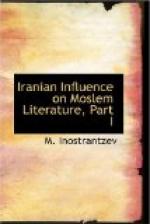in the world. But no one knew its meaning.
And it was alleged that it was in a heavenly language
and was called as such. It was entitled Ashta
[this is clearly a misformation of Avesta]. Then
he left Azarbayjan and proceeded towards Fars.
No one knew what was in the book and no one accepted
it. Then he went to India and produced it before
the kings there. Next he went to China and Turkey.
But no one acknowledged it, and he was driven out
from their countries, and started for Farghana whose
king prepared to slay him so that he fled from there
and bent his steps towards Bhishtasb son of Loharasp;
who ordered his imprisonment and he was consequently
in captivity for a time. Now Zaradusht wrote a
commentary on his Book called the Zend which means
interpretation. Next he commented upon the Zend
in a book called Bazand, that is, interpretation of
interpretation, and therein are various sciences like
astrology, astronomy, medicine,
etc., with reference
to the history of past ages, and the books of the
prophets. And in his book is stated,—“Adhere
to what I have brought you till the time when there
will come to you the man of the red camel,” which
means Muhammad the Prophet. This was at the beginning
of the year 1600 and it was on this account that there
has been enmity between the Magians and the Arabs and
it has been mentioned in the history of Sabur Dhul
Aktaf that this was one of the reasons justifying
the raids on the Arabs. But God knows the best.
[Sidenote: The Eternal fire.]
[Sidenote: Royal archives forbidden to the Vulgar.]
Then Bishtasb caused Zaradusht to present himself
before him since he was in Balkh. And when he
came to him he commenced with his religion. Bishtasb
admired it, followed it, and forced his people to embrace
it, and slew a large number of them till the rest
adopted it. But the Magians assert that he was
by origin from Azarbayjan and that he came to the
king from the roof of his palace and that there was
in his hand a cube of fire with which he played without
its injuring him; that whoever took it from his hand
did so without hurting himself. He caused the
king to follow him and to accept his creed. And
he built fire temples in the country and lighted them
with that fire. For it is stated that the fires
which are in their fire-temples are burning from that
fire to this day. But they are telling an untruth
since the fire of the Magians was extinguished in
all their temples when God sent Muhammad down as his
apostle as we shall describe, God willing, in the sequel,
as well as the appearance of Zaradusht after thirty
years of the reign of Bishtasb. And Zaradusht
brought a writing which is alleged to be revelation
from God and is inscribed on 12,000 cow hides inlaid
with gold. Bishtasb deposited them in a place
in Istakhar and forbade the teaching of thorn to the
vulgar.
MASUDI.
Kitab-at-tanbih.




